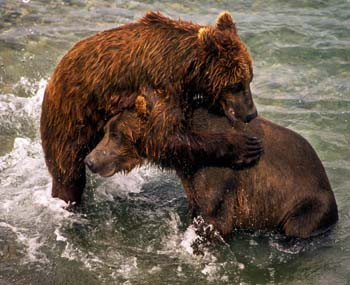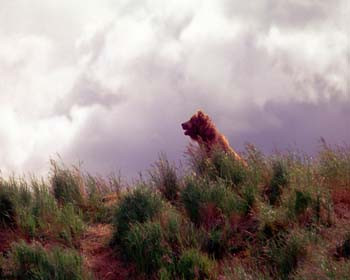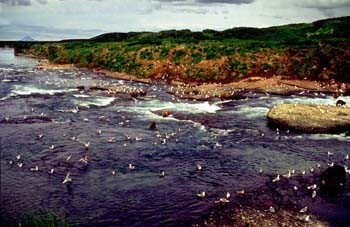
The McNeil River
This is an overview of The McNeil River, Alaska where I took the Grizzly Bear photographs that you will see on the website. It was late August, and the bears were feasting and fattening up on the salmon that were returning to the same fresh water, from which they had hatched some 2-1/2 years earlier. They would soon go into hibernation where they fall asleep for several months. Bears are inseminated in the summer, but they have the ability to delay nidation until they find a den site and fall asleep. The impregnated females will bear, without awakening, 1-3 babies. During hibernation, the bear will not eat, defecate or urinate until they awaken the following March or early April! The one pound newborn infants, on their own initiative, will find and feed on the mother's teats, from which they will grow and prosper on her rich milk. When she does awaken, she and the cubs exit the den. She is much thinned down and " Hungry as a bear!" [The McNeil River, Alaska].
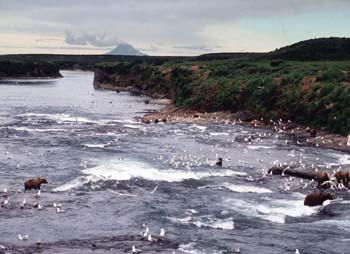
McNeil River
A closer view of the McNeil River with many bears fishing.The white objects are gulls, whose screeching is deafening. They are fighting over the remains of the salmon left by the bears. Smoke can be seen coming out of the active Augustine Island volcano in the distant background. [McNeil River, Alaska].
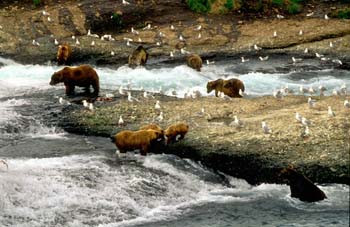
Grizzly Bears Fishing
During the summer and early fall, Grizzly (Brown) Bears will eat as much as they can to store up fat to last them through the winter hibernation--and for the females, adequately to nurse their newborn babies, until they waken in early spring. They will have consumed no food or water during hibernation. The female actually becomes impregnated in late spring or early summer, but the nidation [implantation & development of the fertilized egg(s)] is delayed until early winter (late September-early November). Once they find a suitable den, they proceed to hibernate. The pregnant females will give birth to 2-3 cubs, without awakening or being aware of their birth. (I can hear our ladies saying:"I'll buy that!").The babies weigh about a pound, find the teats, and nurse entirely on their own initiative. [McNeil River, Alaska].
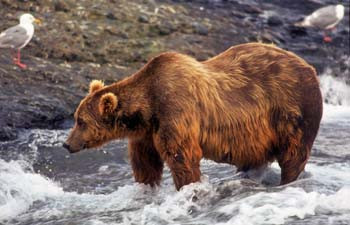
Old Grizzly fishing
The marked sway-back of this male, and the extra respect that all the younger bears in the water displayed, identifies him as an elderly V.I.P. All the bears gave him a wide berth --- and his own fishing space --- as he fished alone in the rapids. [McNeil River, Alaska].
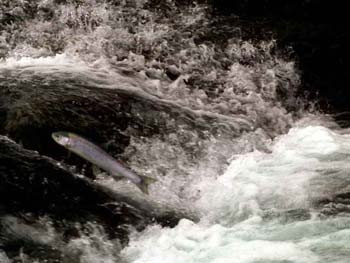
Salmon Shooting Rapids
I watched these Sockeye Salmon shooting the rapids, striving so hard to get back up the rapids to reach the same fresh water pool in which they were spawned (after returning from 2 years at sea in salt water). I marveled at their determination, endurance, and skill. They first had to elude the seals and the fishermen in the ocean, and the bears and rapids in the river. I don't see how enough of them survived to perpetuate their species. [Chenik River, Alaska].
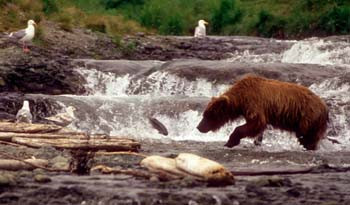
Grizzly Fishing
The grizzly is a superb fisherman who easily catches the airborne sockeye salmon shooting the rapids, or in the water swimming against the stream. They have no trouble compensating for the light refraction of water--even though to us it would cause the location of a fish to seem to be in a different position than it actually is. [McNeil River, Alaska].
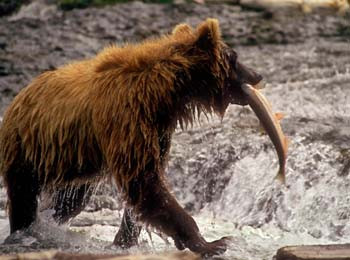
Grizzly with Salmon
The bear caught this salmon in its jaws as the fish was trying to shoot the rapids, and is carrying it to a flat rock to facilitate tearing it apart before eating it. [McNeil River, Alaska].
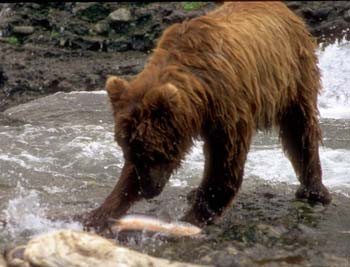
Grizzly Fishing
This young Grizzly almost lost the wriggling sockeye, but the bear put its foot down on the fish's tail--and that was the end of the sockeye! [McNeil River, Alaska].
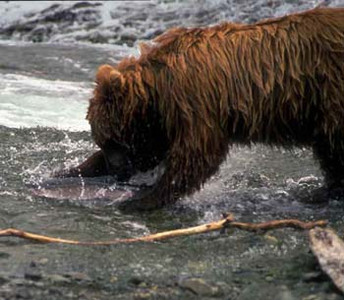
Grizzly Fishing
The Grizzly uses its paw to brush the salmon onto the rocks and one foot to hold down the wriggling fish, as it tears off the skin with its teeth. The bear seeks the fatty layer just beneath the skin, and if it's a female fish, also the eggs. It knows that this is the high-caloric tissue that will best sustain her/him during the forthcoming hibernation. They became glutted and often left behind the much of the fish to be consumed by the gulls. [McNeil River, Alaska].
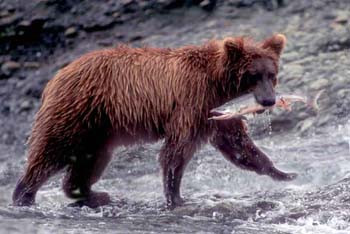
Grizzly Fishing
The young Grizzly has the unfortunate salmon tightly in its jaws. The fish doesn't have a very comfortable expresion. [McNeil River, Alaska].
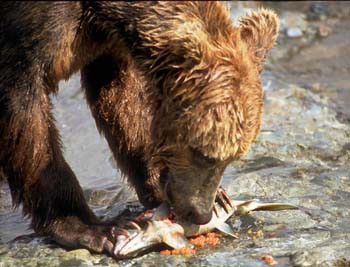
Grizzly Eating
The young Grizzly has eaten some of the salmon's flesh which turns out to be a female. The bear will lick up every last egg, which it has deliberately squeezed out of the salmon, because of the eggs' high caloric content. [McNeil River, Alaska].
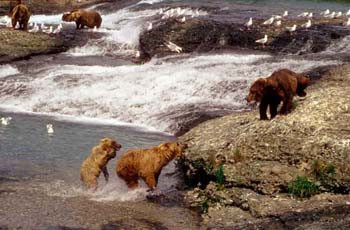
Grizzly Mother & Cubs
Grizzly, mother of 2 last-year's cubs, chases off a young male. He is probably her's from one of her former litters. The sow, with her 2 cubs of two springs ago, chases off the young male cub (3 years old), because she is protecting her current young cubs. At 2 years the cubs are chased off! The cub had previously been chased away and is too old to remain with his mother. She does not intend to hurt him, she just wants him to stay away.The following images show that she is serious about his leaving.[McNeil River, Alaska].
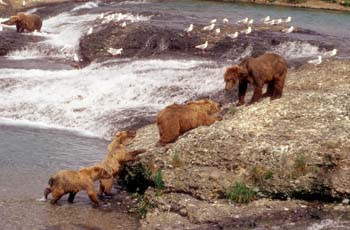
Grizzly Mother & Cubs
Shortly after a young cub reaches 2-3 years old, the mother Grizzly will drive it off. (It is thought that this practice is to prevent inbreeding). The young cub has returned to an area with which he was familiar, but moma now has two new cubs, and she won't tolerate his presence. One of the indications that this male is not a stranger, and nothing serious will happen, is that her present cubs are perfectly relaxed. [McNeil River, Alaska].
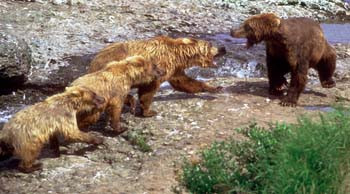
Grizzly Mother & Cubs
The mother Grizzly snarls to scare away the young male, while her present cubs hug her side. [McNeil River, Alaska].
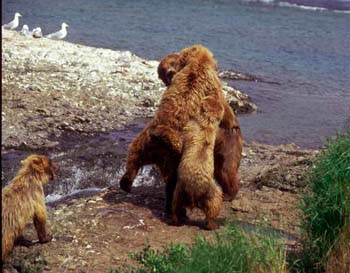
Grizzly Mother & Cubs
Just to make sure, the sow gives him a 'Bear Hug' to let him know that she's serious about his staying away, but she doesn't hurt him. [McNeil River, Alaska].
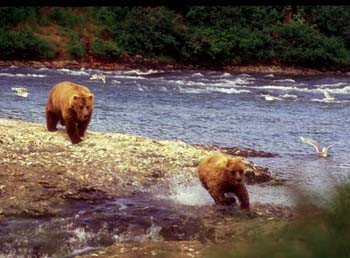
Grizzly Mother and Cubs
The young male Grizzly finally gets the message and flees. The sow pursues for a short distance. [McNeil River, Alaska].
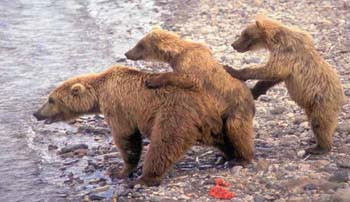
Mother and 2 cubs
A different mother Grizzly and her 2 cubs, which are a year older than 'Spring Cubs', having been born 2 winters ago.The mother takes her cubs down to the river to get them accustomed to the water, and to the presence of other bears. Mothers are excellent teachers, and she will teach them to fish, as well as all the other things they need to know to survive when they are driven out. [McNeil River, Alaska].
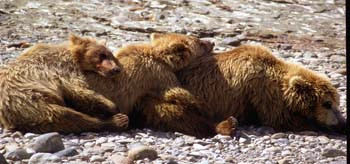
Mother & Two Cubs Resting on the Beach
A mother Grizzly and her two 2-year-old cubs resting on the beach. These are the same individuals as those in the previous image.Their mother will soon be driving them away from her! [McNeil River, Alaska].
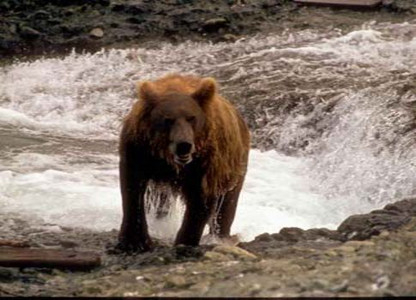
Grizzly Approaching
My guide & I were standing together on the rocks of the Chenik River, watching two young Grizzly Bears fishing, when suddenly one of them wheeled around and came towards us. The three images will show him climbing out onto the rocks, very close to where we were standing. Note the water pouring off his fur. [McNeil River, Alaska].
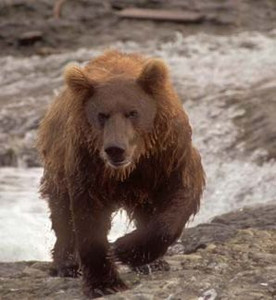
Grizzly Approaching
The young Grizzly has climbed out of the water, and onto the rocks. This approximately four-year-old seemed intent on finding out more about us, because he kept coming closer and closer. Note the toed-in position of his feet. [Chenik River, Alaska].
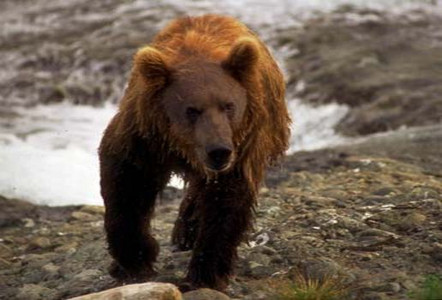
Grizzly Approaching
We were standing no more than 10 feet behind that small log that you can see in the foreground. We remained absolutely still & close together. Suddenly, my guide took a stance and pointed his rifle towards the advancing bear, and yelled "Stop". The bear paused, thought a moment, and then returned to the river. This is the closest call I have ever had with wild animals. I guess this young fellow was just curious. (I have become accustomed to being close to wild animals from many safari trips to Africa). [Chenik River, Alaska].
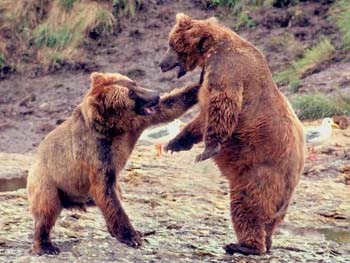
Grizzly Greeting
Two Grizzly males 'greeting' each other: "Hi, Sam! Ain't seen ya since last year! How ya been?". The one on the L is the younger of the two. [McNeil River, Alaska].
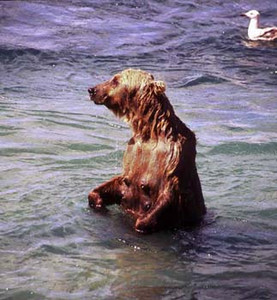
Grizzly (F) in the River
An adult female Grizzly was enjoying a leisurely bath.The water temperature was around 50 degrees F. [McNeil River, Alaska].
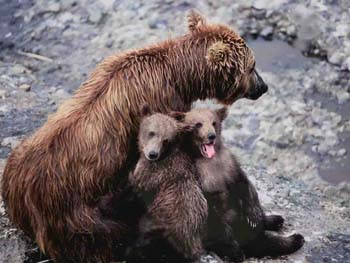
Grizzly with Spring Cubs
Grizzly Sow with two spring cubs: These pictures were taken in mid-August. The term 'Spring Cubs' means that they were just born this past winter in their den while their mother was hibernating. She is very protective of them, and growled and snarled at any other bears that came within 50 feet.--- like the two older males playfighting in the next three images. [McNeil River, Alaska].
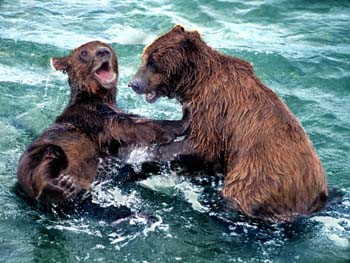
Cubs Play Fighting
In this and the next 2 images, two five-year-old male grizzlies are enjoying playing all day long in 50 degree (F.) water. Their carousing elicited a lot of growling from the sow with the two spring cubs in the previous image, even though they never came close to her or her cubs. I guess she just wanted them to repect her, and her cubs' presence. [McNeil River, Alaska].
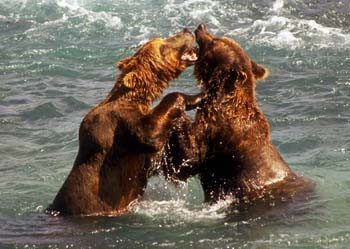
Cubs Play Fighting
These two Grizzlies are the same two males playing in the water, as those in the preceding image, and in the next image. [McNeil River, Alaska].
